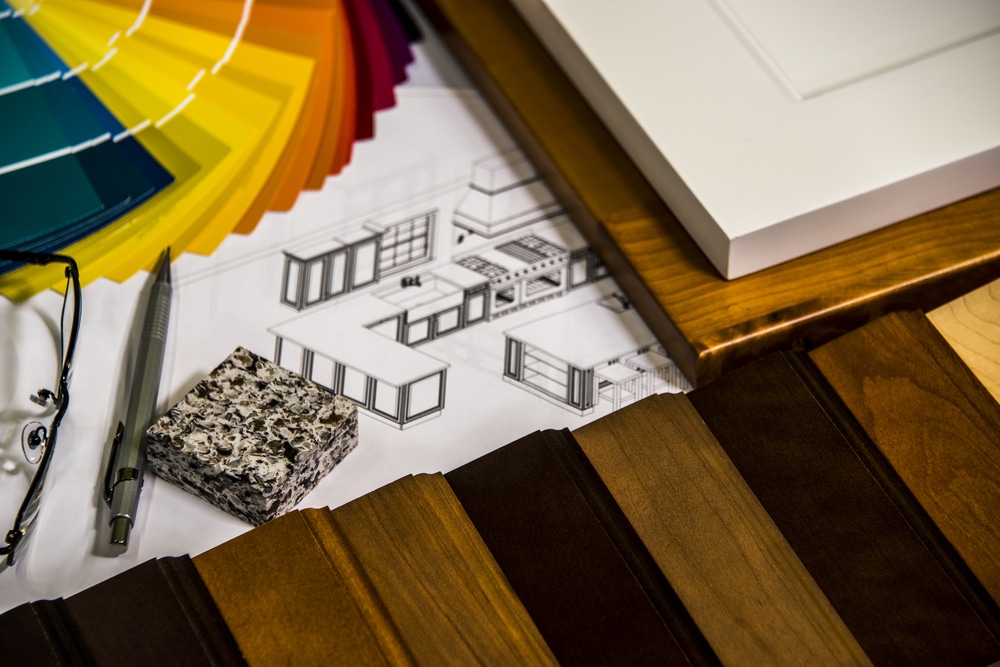We face many decisions in any home renovation – not least of all is the kitchen. Aside from the tricky aesthetics such as countertops and backsplash, wall color, and front finish of the cabinets, there are all of the structural issues as well. Countertops and cabinets are great examples of where function and form need to be balanced just perfectly – we want them to last years to come, but we don’t want to sacrifice a beautiful kitchen for a durable one.
What’s behind the beautiful wood finish?
Behind the beautiful wood finish of the cabinets, or in many cases, the painted or glass doors, you have the cabinet box that holds it all together. This is behind the doors and under the counters, it makes up the back, top, sides, bottom, and even the shelves.
The main two options we typically see are plywood and particle board. How do you know which will work better in your home? If you are unfamiliar with the difference between these two, that is because they are actually quite similar in a way.
Each one relies on glue adhesive to gain their supreme durability. Glue is used in plywood to adhere several layers of wood veneer together with alternating grain to add stability, whereas particle board uses glue to connect smaller wood fibers together into sort of a pressed board, often with a mold used. Each type of wood has its own benefits and should be considered individually for your particular set of needs.
Plywood has long been thought to be a vastly superior construction material, particularly with cabinets. This honor was not given to plywood lightly by any means. It gets its durability from its layers, particularly with the grain being altered, which means that if each layer were to break it would do so in a different direction. Therefore, each layer resists breakage due to the opposing forces on either side of it.
Plywood is also advantageous in holding mechanical fasteners efficiently, meaning that a screw will stay in place very well within the plywood’s layers. Compressive strength is another advantage of plywood, meaning that it has a high weight-bearing ability, despite the fact that it is light in weight compared to particle board. Last, its tensile and shearing properties are superior, making it efficient in resisting pulling motions and side-to-side forces.
While it may seem as though plywood is quickly pulling ahead here, consider the advantages of particle board. It has dimensional stability that far outweighs that of plywood, due to its smaller pieces adhered together. This means that warping is minimized, even with fluctuations in temperature or other environmental factors.
Particle board has one extremely significant advantage, which is that it costs much less than plywood – or most materials for that matter. In fact, a homeowner can save approximately 8-12% on their cabinets when the boxes are made from particle board. This may or may not be outweighed by their lack of moisture resistance, which can also be addressed with a sealant.
MDF and HDF
Other types of material to consider include MDF and HDF material. You may wonder what is the difference between particle board, MDF and HDF?
MDF stands for medium density fiberboard. This is a wood composite made up of wood fibers. There is no visible wood grain, rings, or knots. Advantages are that it’s low cost, smooth, east to pain, and actually stronger than particle board. However, you can’t stain it and it can be quite heavy.
HDF which stands from high-density fiberboard. HDF is far denser than particle board or MDF, the density allows for minimal hairline cracking which occurs more on less dense materials. HDF fiberboard is a great choice solid painted finish. This and with the lesser dense but still heavy MDF board, make great choices for a solid painted finish for cabinet doors.
The truth is, these different types of boards can both vary in their individual quality, from one to the next. Keeping these advantages and disadvantages of each one in mind, along with your home’s needs and your budgets, it may be best to ask a professional at Cabinet Era to help steer you in the right direction. After all, the experience that comes from building and installing cabinets for years is a great tool to share with you, in order to help you with your dream kitchen.

